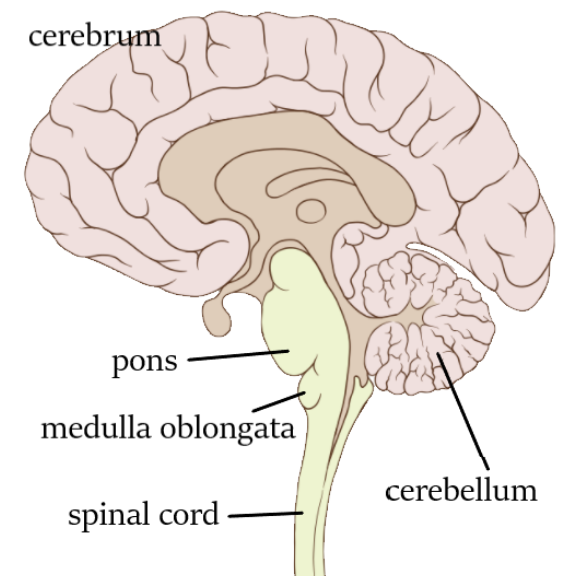
Posture and balance of the body is controlled by
A. Cerebrum
B. Cerebellum
C. Medulla
D. Pons
Answer
451.8k+ views
Hint: The brain is one of the largest and most complex organs in the human body. Its origin word means “little brain”, present near the brainstem.
Complete Answer:
The responsible part of the brain for coordinating postures and the voluntary movements of skeletal muscles has a Latin origin which means ‘little brain’ and but actually holds a significant role in the hindbrain. Any abnormality or damage in this area may cause troubled posture, balance, and non-coordinated voluntary motor muscles.

Additional information:
- Possibly it holds a significant role in cognition and language processing.
- The cerebrum is the most significant and largest portion of the human brain. The cerebral cortex is divided into three parts: sensory and motor areas. The perception of sensory information is due to sensory areas, the executions of voluntary movements are executed by motor areas. Few complex integrative functions such as memory, personality traits, and intelligence rely on the association areas of the cerebral cortex. Therefore cerebrum coordinates with other parts of the brain for better functioning of the brain. A range of emotions like anger, affection, pleasure, fear, pain, etc. are promoted by the limbic system.
- Medulla oblongata consists of ascending sensory tracts and descending motor tracts. The heartbeat and blood vessel diameter are controlled by the cardiovascular central regulator. Breathing rhythms and other vital functions are also controlled by this region.
- Pons contains both sensory and motor tracts. Pontine nuclei relay nerve impulses from motor areas of the cerebral cortex to the cerebellum. Also, vestibular nuclei are part of the equilibrium pathway to the brain. Also, help to control breathing and connect the spinal cord with the brain.
Therefore the correct answer is B, i.e. cerebellum.
Note: The cerebellum appears like a small separated part of the brain. But it is significantly large, divided into 2 cortex, similar to the cerebrum namely the cerebellar cortex and cerebellar nuclei. Out of the total volume of the brain, the cerebellum holds 10% only, yet it has roughly 50-80% neurons of the brain.
Complete Answer:
The responsible part of the brain for coordinating postures and the voluntary movements of skeletal muscles has a Latin origin which means ‘little brain’ and but actually holds a significant role in the hindbrain. Any abnormality or damage in this area may cause troubled posture, balance, and non-coordinated voluntary motor muscles.

Additional information:
- Possibly it holds a significant role in cognition and language processing.
- The cerebrum is the most significant and largest portion of the human brain. The cerebral cortex is divided into three parts: sensory and motor areas. The perception of sensory information is due to sensory areas, the executions of voluntary movements are executed by motor areas. Few complex integrative functions such as memory, personality traits, and intelligence rely on the association areas of the cerebral cortex. Therefore cerebrum coordinates with other parts of the brain for better functioning of the brain. A range of emotions like anger, affection, pleasure, fear, pain, etc. are promoted by the limbic system.
- Medulla oblongata consists of ascending sensory tracts and descending motor tracts. The heartbeat and blood vessel diameter are controlled by the cardiovascular central regulator. Breathing rhythms and other vital functions are also controlled by this region.
- Pons contains both sensory and motor tracts. Pontine nuclei relay nerve impulses from motor areas of the cerebral cortex to the cerebellum. Also, vestibular nuclei are part of the equilibrium pathway to the brain. Also, help to control breathing and connect the spinal cord with the brain.
Therefore the correct answer is B, i.e. cerebellum.
Note: The cerebellum appears like a small separated part of the brain. But it is significantly large, divided into 2 cortex, similar to the cerebrum namely the cerebellar cortex and cerebellar nuclei. Out of the total volume of the brain, the cerebellum holds 10% only, yet it has roughly 50-80% neurons of the brain.
Recently Updated Pages
Master Class 10 General Knowledge: Engaging Questions & Answers for Success

Master Class 10 Computer Science: Engaging Questions & Answers for Success

Master Class 10 Science: Engaging Questions & Answers for Success

Master Class 10 Social Science: Engaging Questions & Answers for Success

Master Class 10 Maths: Engaging Questions & Answers for Success

Master Class 10 English: Engaging Questions & Answers for Success

Trending doubts
The Equation xxx + 2 is Satisfied when x is Equal to Class 10 Maths

Why is there a time difference of about 5 hours between class 10 social science CBSE

Who was Subhash Chandra Bose Why was he called Net class 10 english CBSE

Change the following sentences into negative and interrogative class 10 english CBSE

Write a letter to the principal requesting him to grant class 10 english CBSE

Explain the Treaty of Vienna of 1815 class 10 social science CBSE




